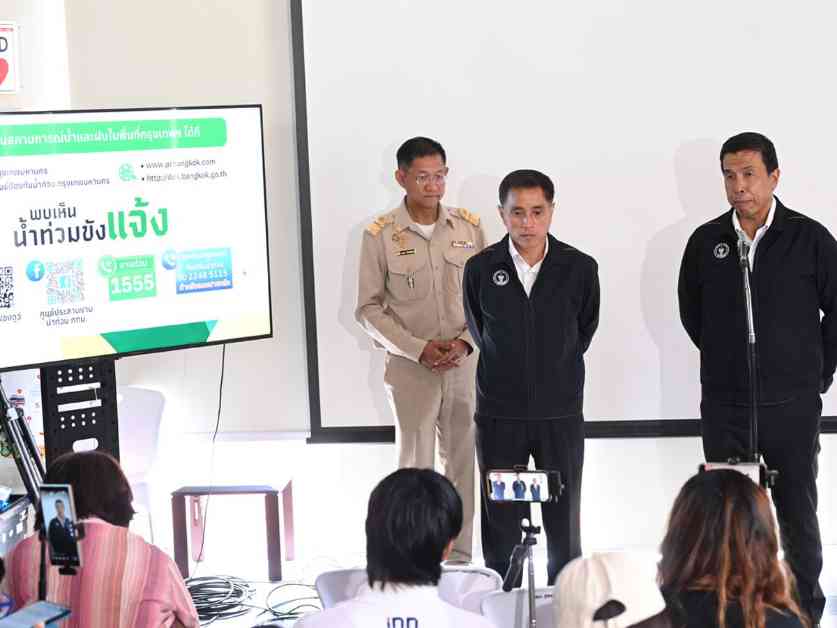Enhancing Dam Defenses and Flood Preparation in Bangkok
The city of Bangkok is taking proactive measures to protect its residents from potential flooding situations by implementing a comprehensive plan that includes 24-hour monitoring, strengthening dam defenses, and preparing for various scenarios. With the threat of heavy rainfall and rising water levels, the authorities are leaving no stone unturned in their efforts to safeguard the city and its inhabitants.
Strategic Measures to Safeguard Bangkok
To fortify the city’s defenses against flooding, Bangkok authorities have mobilized a series of initiatives aimed at enhancing dam infrastructure, closing off vulnerable points, and preparing water pumping stations. Over 60 vulnerable spots have been identified and secured to prevent potential breaches in the event of rising water levels. Additionally, 200 water pumping stations have been readied for immediate deployment in case of emergencies.
Furthermore, efforts are underway to ensure the smooth flow of water through 1,300 canals and to clean out 4,300 kilometers of drainage pipes. This proactive approach aims to minimize the risk of blockages and ensure that excess water can be effectively drained away from populated areas.
Mr. Wisanu Tharap, Deputy Governor of Bangkok, emphasized the importance of preparedness in the face of potential flooding incidents. He highlighted the need for continuous monitoring and coordination with relevant agencies to stay ahead of any developments that could lead to water overflow and inundation in the city.
Monitoring and Evaluation of Dam Defenses
One of the key areas of focus for Bangkok authorities is the monitoring and evaluation of dam defenses along the Chao Phraya River. From the tourist pier under the Phra Pin-Klao Bridge in the Phra Nakhon district to Wat Sroy Thong in Bang Sue district, the city is actively assessing the readiness of its flood defenses.
The management of Bangkok’s water discharge facilities is also under scrutiny, with a particular emphasis on the four main dams that regulate the flow of the Chao Phraya River. Comparative assessments conducted on the same date over two consecutive years have shown improvements in the capacity of these dams to handle increased water volumes, providing a sense of reassurance to residents.
Despite the positive developments, authorities remain vigilant in their monitoring efforts, especially in light of heavy rainfall in northern regions that could lead to rapid increases in water levels in the Chao Phraya River. Close coordination with relevant agencies such as the Department of Irrigation, the National Water Command Center, and the National Water Resources Office is key to ensuring a proactive response to potential flooding incidents.
Community Preparedness and Emergency Response
In addition to bolstering dam defenses and monitoring water levels, Bangkok authorities are also focusing on enhancing community preparedness and emergency response capabilities. Sixteen communities comprising 731 households along the Chao Phraya River have been identified as high-risk areas that could be affected by flooding.
To mitigate the impact on these communities, the Bangkok Metropolitan Administration has instructed local offices in seven districts, including Dusit, Phra Nakhon, Samphanthawong, Bang Kho Laem, Yan Nawa, Bangkok Noi, and Khlong San, to disseminate information and prepare for potential evacuations. Residents are advised to relocate their belongings to higher ground to minimize the impact of rising water levels.
Moreover, authorities are conducting surveys of riverside communities to assess their vulnerability and readiness to respond to emergencies. This proactive approach aims to ensure that resources and personnel are deployed promptly to assist residents in case of unforeseen events.
Weather Patterns and Flood Preparedness
While the threat of flooding looms large, Bangkok has demonstrated resilience in its response to weather patterns and flood preparedness. Comparing rainfall data from previous years, the city has shown a remarkable ability to manage rainfall and minimize the impact on its infrastructure and residents.
In August alone, Bangkok received 208.5 millimeters of rainfall, a slight decrease from the previous year’s total of 224 millimeters. The cumulative rainfall for the year stood at 842.5 millimeters, closely mirroring the figures from the previous year. These statistics indicate that Bangkok is well-equipped to handle rainfall events and has taken proactive measures to mitigate the risk of flooding.
The city’s continuous efforts to reduce water levels through various initiatives, such as canal dredging, water bank construction, and maintenance of drainage systems, have significantly contributed to its ability to cope with heavy rainfall and prevent flooding incidents. By maintaining a high level of preparedness and investing in infrastructure upgrades, Bangkok remains at the forefront of flood prevention and emergency response in the region.
In conclusion, Bangkok’s commitment to enhancing dam defenses, strengthening flood preparedness, and fostering community resilience is commendable. By adopting a proactive approach to monitoring water levels, evaluating dam infrastructure, and engaging with stakeholders, the city is setting a benchmark for effective flood management strategies. With the threat of flooding ever-present, Bangkok’s comprehensive plan serves as a model for other cities facing similar challenges in safeguarding their residents and infrastructure.



















